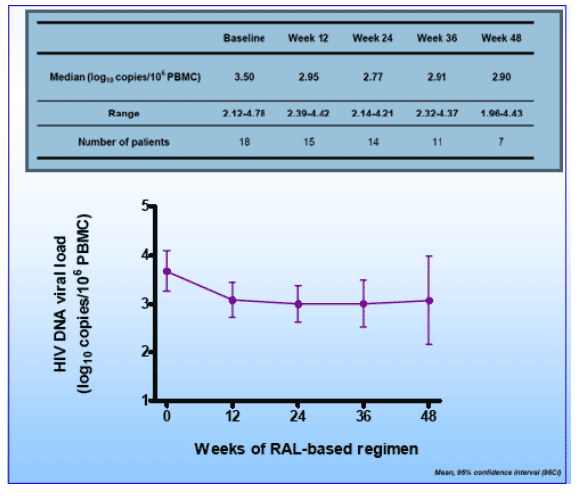 |
 |
 |
| |
HIV DNA Viral Load Evolution under a Raltegravir-based Therapy: modest decline, authors say "these findings suggest raltegravir may be protective from infection to newly CD4 cells generated during treatment"
|
| |
| |
Reported by Jules Levin
XVII HIV Drug Resistance Workshop
June 10-14, 2008
Sitges, Spain
C Charpentier1,2, C Piketty3 , D Laureillard3, P Tisserand1, L Weiss2, 3, L Belec1,2, and A Si-Mohamed1
1. Laboratoire de Virologie, Hopital Europeen Georges Pompidou, Paris, France;
2. Universite Paris V, Faculte de Medecine Rene Descartes, Paris, France; 3. Service d'Immunologie Clinique, Hopital Europeen Georges Pompidou, Paris, France.
AUTHOR CONCLUSIONS
⋅ Our data showed no drastic effect of RAL on total HIV DNA level, with a median decrease of -0.35 log10 copies/106 PBMC at W12;
⋅ Noteworthy, HIV DNA decrease occurs early following the initiation of RAL, during the first three months of the RAL-based regimen, especially in patients highly ARV-experienced;
⋅ In addition, when HIV DNA was reported to the proportion of CD4 cell count, a correlation was found with the magnitude of HIV RNA decrease;
⋅ Thus, these findings suggest that RAL may be protective from infection to newly CD4 cells generated during treatment.
BACKGROUND
⋅ The recent antiretroviral (ARV) drug class of integrase inhibitors, including raltegravir (RAL), targets HIV integration process;
⋅ This mechanism of action may support the hypothesis of a possible impact of this ARV drug class also on HIV DNA viral load level;
⋅ However, few data are available about evolution of HIV DNA during a RAL-based regimen.
MATERIALS & METHODS
⋅ Eighteen highly experienced-patients initiated a RAL-containing salvage regimen;
⋅ Plasma and Peripheral Blood Mononuclear Cells samples were collected for all patients at baseline, and for available samples at week 12 (W12), W24, W36 and W48 of RAL-based regimen;
⋅ At each of these time-points HIV RNA and DNA viral loads were assessed;
⋅ HIV RNA quantification was performed by using the COBAS TaqMan HIV-1 test (Roche Molecular systems, Branchburg, NJ);
⋅ HIV DNA quantification assessed total HIV DNA, measuring both integrated and unintegrated HIV DNA, using the realtime PCR procedure previously described with the NEC005, NEC131 primers, and the MLC1 probe (Schvachsa et al., J Virol Methods, 2007).
RESULTS
⋅ Baseline HIV RNA level and CD4 cells count were 4.05 log10 copies/ml (range: 2.00-5.56) and 29 cells/mm3 (range: 3-109), respectively;
⋅ Among the 18 patients, 3 displayed a virological failure under the RAL-based salvage therapy, associated with integrase gene mutations, these three patients were then excluded from the study
⋅ At W12, median HIV DNA viral load was of 2.95 log10 copies/106 PBMC (range: 2.39-4.42).
The median decrease of HIV DNA level between baseline and W12 was of -0.35 log10 copies/106 PBMC
(range: -0.12 to -2.26 log10 copies/106 PBMC), and of -0.48 log10 copies /106 PBMC in mean

⋅ The degree of HIV DNA decrease does not correlate with CD4 cell count or HIV RNA level at baseline;
⋅ The degree of HIV DNA decrease was found to be correlated with HIV DNA baseline level (R = 0.28; P = 0.03);
⋅ The HIV DNA level / CD4 cell count ratio decrease between baseline and W12 was correlated with the magnitude of the HIV RNA level reduction (R = 0.35; P = 0.01).
|
| |
|
 |
 |
|
|